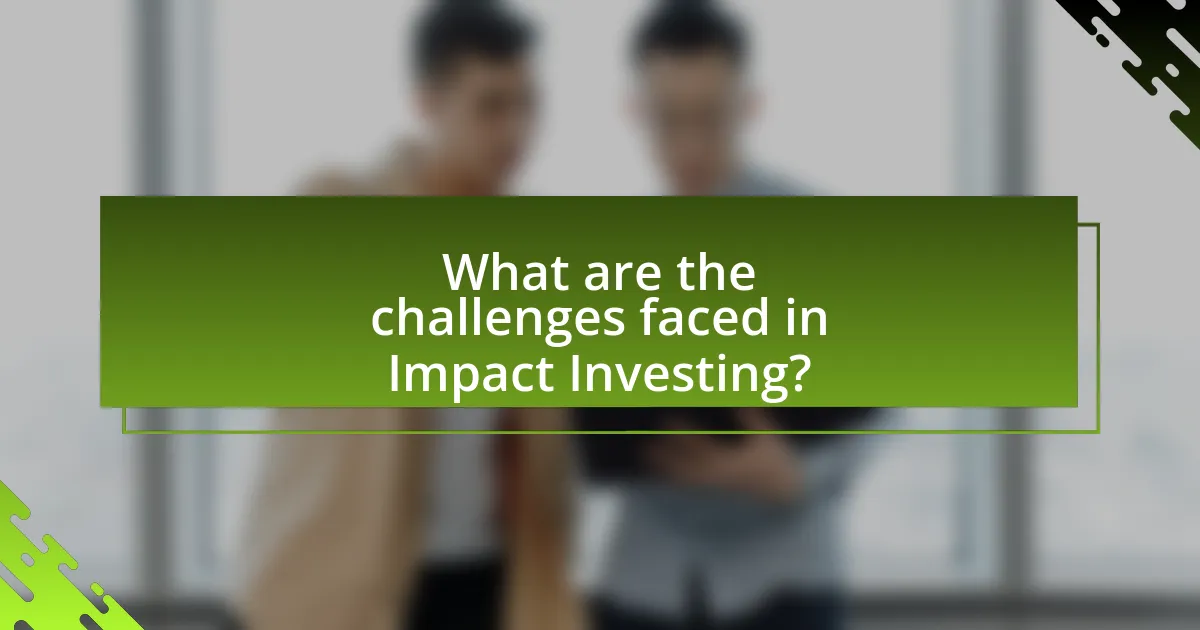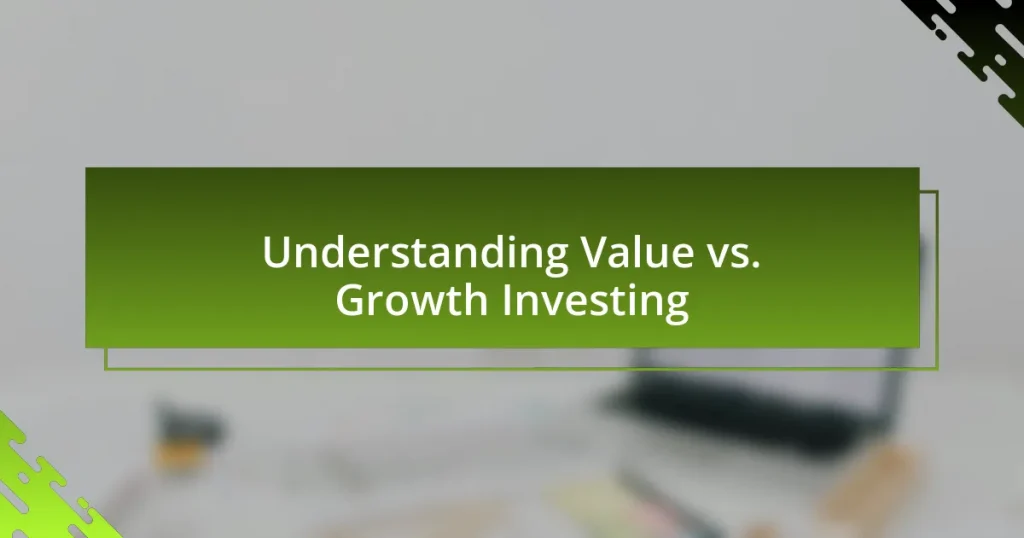Impact investing is an investment strategy that seeks to generate positive social and environmental impacts alongside financial returns. This article explores the growth of impact investing, highlighting its distinction from traditional investing, key principles, and the motivations driving investors towards this approach. It examines historical developments, societal changes, and global challenges that have influenced the rise of impact investing, as well as the financial viability and alignment with sustainable development goals. Additionally, the article addresses the challenges and barriers faced in the impact investing space, the role of technology, and best practices for investors to ensure their values align with their investment choices.

What is Impact Investing?
Impact investing is an investment strategy that aims to generate positive social and environmental impacts alongside financial returns. This approach allows investors to support initiatives that address societal challenges, such as poverty alleviation, education, and climate change, while also seeking competitive financial performance. According to the Global Impact Investing Network (GIIN), the impact investing market reached approximately $715 billion in assets under management as of 2020, demonstrating significant growth and interest in aligning financial goals with social values.
How does Impact Investing differ from traditional investing?
Impact investing differs from traditional investing primarily in its dual focus on financial returns and social or environmental impact. While traditional investing prioritizes maximizing financial gains without necessarily considering social outcomes, impact investing intentionally seeks to generate positive societal effects alongside competitive financial returns. For instance, according to the Global Impact Investing Network, impact investments are made with the intention to contribute to measurable social or environmental benefits, which is a fundamental distinction from the profit-centric approach of traditional investments.
What are the key principles of Impact Investing?
The key principles of Impact Investing include intentionality, financial return, and measurable impact. Intentionality refers to the commitment to generate positive social and environmental outcomes alongside financial returns. Financial return emphasizes that investments should yield a financial profit, aligning with traditional investment goals. Measurable impact involves assessing and reporting the social and environmental effects of investments, ensuring accountability and transparency. These principles guide investors in making decisions that align their financial goals with their values, fostering a sustainable and responsible investment landscape.
Why is the distinction between financial return and social impact important?
The distinction between financial return and social impact is important because it allows investors to evaluate the dual outcomes of their investments, ensuring that financial gains do not come at the expense of societal benefits. This differentiation is crucial in impact investing, where investors seek to generate measurable social or environmental impact alongside a financial return. For instance, a study by the Global Impact Investing Network (GIIN) found that 88% of impact investors reported that they achieved their financial goals while also making a positive social impact, demonstrating that these two objectives can coexist and reinforce each other. Understanding this distinction helps investors make informed decisions that align with their values and contribute to sustainable development.
What are the historical developments that led to the rise of Impact Investing?
The rise of Impact Investing is primarily attributed to the convergence of social responsibility movements, financial innovation, and the growing recognition of environmental, social, and governance (ESG) factors in investment decisions. In the 1960s and 1970s, socially responsible investing (SRI) emerged, focusing on avoiding investments in industries like tobacco and arms. This was followed by the establishment of the first socially responsible mutual funds in the 1980s, which allowed investors to align their portfolios with their values.
The 1990s saw the introduction of the term “impact investing,” popularized by organizations such as the Rockefeller Foundation, which emphasized investments that generate measurable social and environmental benefits alongside financial returns. The Global Impact Investing Network (GIIN), founded in 2010, further solidified the field by providing a platform for investors to share best practices and metrics for impact measurement.
By 2020, the impact investing market had grown significantly, with estimates suggesting it reached over $715 billion in assets under management, reflecting a broader acceptance of the idea that financial markets can be leveraged for social good. This historical trajectory illustrates how societal shifts, financial product development, and institutional support have collectively contributed to the rise of Impact Investing.
How have societal changes influenced the growth of Impact Investing?
Societal changes have significantly influenced the growth of Impact Investing by increasing awareness and demand for socially responsible investment options. The rise of environmental, social, and governance (ESG) criteria among investors reflects a shift in public values towards sustainability and ethical practices. For instance, a 2021 report from the Global Impact Investing Network indicated that the global impact investing market reached $715 billion, driven by a growing preference for investments that generate positive social and environmental outcomes alongside financial returns. This trend is further supported by younger generations, who prioritize purpose-driven investments, leading to a substantial increase in capital directed towards impact-focused ventures.
What role do global challenges play in the emergence of Impact Investing?
Global challenges significantly drive the emergence of Impact Investing by highlighting the urgent need for sustainable solutions to social and environmental issues. As problems such as climate change, poverty, and inequality escalate, investors increasingly seek opportunities that not only yield financial returns but also generate positive societal impact. For instance, the Global Impact Investing Network reported that the global impact investing market reached $715 billion in 2020, reflecting a growing recognition among investors that addressing these challenges can align with their financial goals. This shift is further supported by the United Nations’ Sustainable Development Goals, which provide a framework for investors to target specific global challenges while pursuing profitability.

Why is Impact Investing gaining popularity?
Impact investing is gaining popularity due to a growing awareness of social and environmental issues among investors. This shift is driven by the desire to achieve financial returns while also making a positive impact on society. According to the Global Impact Investing Network, the impact investing market reached $715 billion in 2020, reflecting a significant increase in interest and commitment from both institutional and individual investors. Additionally, millennials and younger generations prioritize sustainability and ethical considerations in their investment choices, further propelling the trend.
What are the motivations behind investors choosing Impact Investing?
Investors choose Impact Investing primarily to achieve both financial returns and positive social or environmental impact. This dual motivation is driven by a growing awareness of global challenges, such as climate change and social inequality, prompting investors to seek opportunities that align with their values. According to the Global Impact Investing Network, the impact investing market reached $715 billion in 2020, indicating a significant trend among investors prioritizing ethical considerations alongside traditional financial metrics.
How do personal values influence investment decisions?
Personal values significantly influence investment decisions by guiding investors toward opportunities that align with their ethical beliefs and social priorities. For instance, individuals who prioritize environmental sustainability may choose to invest in renewable energy companies or funds that focus on eco-friendly practices. Research indicates that 70% of millennials are interested in sustainable investing, reflecting a shift in investment behavior driven by personal values. This alignment not only fulfills ethical considerations but can also enhance financial performance, as companies with strong sustainability practices often demonstrate resilience and long-term profitability.
What evidence supports the financial viability of Impact Investing?
Impact investing demonstrates financial viability through consistent performance metrics and growing market demand. Research by the Global Impact Investing Network (GIIN) indicates that 88% of impact investors reported meeting or exceeding their financial expectations, showcasing the sector’s potential for competitive returns. Additionally, the Global Sustainable Investment Alliance reported that sustainable investment assets reached $35.3 trillion in 2020, reflecting a 15% increase over two years, which underscores the increasing interest and confidence in impact investing as a viable financial strategy.
How does Impact Investing align with sustainable development goals?
Impact investing aligns with sustainable development goals (SDGs) by directing capital towards projects that generate measurable social and environmental benefits alongside financial returns. This investment approach supports various SDGs, such as poverty alleviation (Goal 1), gender equality (Goal 5), and climate action (Goal 13), by funding initiatives that address these critical issues. For instance, according to the Global Impact Investing Network, impact investments have mobilized over $715 billion towards sustainable development, demonstrating a clear commitment to achieving the SDGs.
What specific goals are most commonly targeted by Impact Investors?
Impact investors commonly target specific goals such as environmental sustainability, social equity, and economic development. These goals are often aligned with the United Nations Sustainable Development Goals (SDGs), which provide a framework for addressing global challenges. For instance, impact investors frequently focus on clean energy initiatives to combat climate change, affordable housing projects to promote social equity, and job creation efforts to stimulate economic growth. According to the Global Impact Investing Network (GIIN), over 70% of impact investors prioritize environmental and social outcomes alongside financial returns, demonstrating a clear commitment to these specific goals.
How can Impact Investing contribute to environmental sustainability?
Impact investing can significantly contribute to environmental sustainability by directing capital towards projects and companies that prioritize ecological health and resource conservation. This investment approach supports renewable energy initiatives, sustainable agriculture, and conservation efforts, which collectively aim to reduce carbon emissions and promote biodiversity. For instance, according to the Global Impact Investing Network, impact investments in renewable energy have the potential to reduce greenhouse gas emissions by up to 70% by 2050. By aligning financial returns with positive environmental outcomes, impact investing fosters innovation and scalability in sustainable practices, ultimately leading to a more sustainable economy.

What are the challenges faced in Impact Investing?
Impact investing faces several challenges, including measuring social and environmental impact, balancing financial returns with social goals, and navigating regulatory complexities. Measuring impact is difficult due to the lack of standardized metrics, making it hard for investors to assess the effectiveness of their investments. Additionally, investors often struggle to find opportunities that align both with their financial expectations and their social or environmental objectives, leading to potential trade-offs. Regulatory complexities can also hinder impact investing, as varying regulations across regions can create barriers to entry and compliance challenges for investors.
What barriers exist for investors in the Impact Investing space?
Barriers for investors in the Impact Investing space include a lack of standardized metrics for measuring impact, limited access to quality deal flow, and perceived trade-offs between financial returns and social/environmental outcomes. The absence of universally accepted impact measurement frameworks makes it difficult for investors to assess the effectiveness of their investments, leading to uncertainty. Additionally, many investors struggle to find viable investment opportunities that align with their values, as the market for impact investments is still developing. Research from the Global Impact Investing Network indicates that 70% of impact investors cite the challenge of measuring impact as a significant barrier, highlighting the need for improved standards and transparency in the sector.
How does measuring impact complicate investment decisions?
Measuring impact complicates investment decisions by introducing challenges in quantifying social and environmental outcomes alongside financial returns. Investors often face difficulties in establishing standardized metrics for impact assessment, leading to inconsistencies in data interpretation. For instance, a study by the Global Impact Investing Network (GIIN) highlights that 70% of impact investors cite measurement as a significant barrier to scaling their investments. This complexity can result in uncertainty regarding the true value of investments, making it harder for investors to align their financial goals with their values effectively.
What are the risks associated with Impact Investing?
Impact investing carries several risks, including financial, market, and operational risks. Financial risks arise from the potential for lower returns compared to traditional investments, as impact investments may prioritize social or environmental outcomes over profit maximization. Market risks include the volatility associated with sectors that impact investments often target, such as renewable energy or affordable housing, which can be influenced by regulatory changes or economic shifts. Operational risks stem from the challenges of measuring and reporting social impact, which can lead to difficulties in assessing the effectiveness of investments. According to a report by the Global Impact Investing Network, 43% of impact investors reported challenges related to measuring impact, highlighting the complexities involved in this investment approach.
How can investors overcome challenges in Impact Investing?
Investors can overcome challenges in impact investing by adopting a clear framework for measuring social and environmental outcomes alongside financial returns. This approach enables investors to assess the effectiveness of their investments in achieving desired impacts, thereby addressing concerns about accountability and transparency. For instance, the Global Impact Investing Network (GIIN) emphasizes the importance of standardized metrics, such as the IRIS+ system, which provides a comprehensive catalog of metrics for measuring impact. By utilizing these tools, investors can make informed decisions, mitigate risks, and enhance the credibility of their impact investments.
What strategies can be employed to effectively measure impact?
To effectively measure impact, organizations can employ strategies such as establishing clear metrics, utilizing data collection tools, and conducting regular evaluations. Clear metrics, such as specific social or environmental outcomes, provide a framework for assessing progress. Data collection tools, including surveys and analytics software, facilitate the gathering of relevant information. Regular evaluations, which can be conducted annually or biannually, allow organizations to analyze the effectiveness of their initiatives and make necessary adjustments. These strategies are supported by the Global Impact Investing Network, which emphasizes the importance of measurement in achieving accountability and transparency in impact investing.
How can collaboration enhance the effectiveness of Impact Investing?
Collaboration can enhance the effectiveness of impact investing by pooling resources, expertise, and networks among diverse stakeholders. When investors, nonprofits, and businesses work together, they can leverage each other’s strengths to identify and scale solutions that address social and environmental challenges more effectively. For instance, a study by the Global Impact Investing Network (GIIN) highlights that collaborative efforts can lead to increased capital mobilization, improved risk management, and enhanced measurement of impact, ultimately resulting in more sustainable outcomes. This synergy not only amplifies the reach of individual initiatives but also fosters innovation through shared knowledge and best practices, making impact investing more efficient and impactful.

What are the future trends in Impact Investing?
Future trends in impact investing include increased integration of Environmental, Social, and Governance (ESG) criteria into investment strategies, a growing focus on measurable social and environmental outcomes, and the rise of technology-driven solutions for impact measurement. The Global Impact Investing Network reported that the impact investing market reached $715 billion in assets under management in 2020, indicating significant growth and interest. Additionally, the trend towards collaborative investing, where multiple stakeholders pool resources for greater impact, is gaining traction, as evidenced by initiatives like the 100% Impact Coalition, which aims to mobilize capital for sustainable development goals.
How is technology shaping the future of Impact Investing?
Technology is significantly shaping the future of impact investing by enhancing transparency, improving data analytics, and facilitating access to investment opportunities. Digital platforms enable investors to track the social and environmental impact of their investments in real-time, fostering accountability. For instance, blockchain technology provides immutable records of transactions, ensuring that funds are used as intended. Additionally, advanced data analytics tools allow investors to assess the potential impact of their investments more accurately, leading to informed decision-making. According to a report by the Global Impact Investing Network, the use of technology in impact investing has increased investor confidence and engagement, driving growth in the sector.
What role do fintech innovations play in expanding access to Impact Investing?
Fintech innovations significantly enhance access to impact investing by lowering barriers to entry and increasing transparency. These technologies enable fractional investing, allowing individuals to invest smaller amounts in impact-focused projects, which broadens participation beyond high-net-worth individuals. For instance, platforms like SeedInvest and Fundrise facilitate investments in social enterprises and real estate projects with social impact, democratizing access. Additionally, fintech solutions improve data analytics and reporting, providing investors with clearer insights into the social and environmental outcomes of their investments, thereby fostering trust and engagement. According to a report by the Global Impact Investing Network, the impact investing market reached $715 billion in 2020, illustrating the growing interest and accessibility driven by fintech advancements.
How can data analytics improve decision-making in Impact Investing?
Data analytics can significantly enhance decision-making in impact investing by providing actionable insights derived from large datasets. By analyzing social, environmental, and financial metrics, investors can identify high-impact opportunities that align with their values and financial goals. For instance, a study by the Global Impact Investing Network (GIIN) found that data-driven approaches can improve the assessment of potential investments, leading to better risk management and enhanced portfolio performance. Furthermore, analytics can track the impact of investments over time, allowing investors to adjust strategies based on real-world outcomes, thereby ensuring that their investments not only yield financial returns but also create meaningful social and environmental benefits.
What best practices should investors follow in Impact Investing?
Investors in impact investing should prioritize clear impact objectives, rigorous due diligence, and ongoing measurement of social and environmental outcomes. Establishing specific goals allows investors to align their financial strategies with desired social impacts, ensuring that investments contribute positively to society. Conducting thorough due diligence involves assessing potential investments for both financial viability and their capacity to deliver on impact promises, which is essential for minimizing risks. Furthermore, implementing frameworks for measuring and reporting outcomes, such as the Global Impact Investing Network’s IRIS metrics, enables investors to track progress and make informed decisions, reinforcing accountability and transparency in their investment strategies.
How can investors ensure alignment between their values and investment choices?
Investors can ensure alignment between their values and investment choices by conducting thorough research on companies’ environmental, social, and governance (ESG) practices before investing. This involves analyzing ESG ratings, which provide insights into how well companies adhere to ethical standards and sustainability goals. For instance, a 2021 report by MSCI found that companies with high ESG ratings tend to outperform their peers in the long run, demonstrating that ethical practices can correlate with financial performance. By prioritizing investments in firms that align with their personal values, such as sustainability or social justice, investors can create a portfolio that reflects their beliefs while also potentially enhancing returns.
What resources are available for new Impact Investors?
New impact investors can access a variety of resources to guide their investment decisions. Key resources include organizations like the Global Impact Investing Network (GIIN), which provides research, tools, and networking opportunities for impact investors. Additionally, platforms such as ImpactAssets offer donor-advised funds and investment options focused on social and environmental impact. Educational resources, including online courses from institutions like Stanford University and Harvard Business School, also equip new investors with essential knowledge on impact investing strategies and metrics. These resources collectively support new impact investors in aligning their financial goals with their values effectively.



